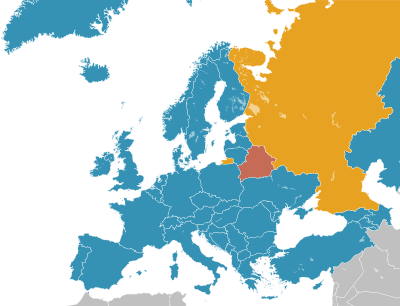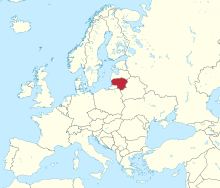Capital punishment in Lithuania


Capital punishment in Lithuania was ruled unconstitutional and abolished for all crimes on 9 December 1998.[1] Lithuania is a member of the Council of Europe and has signed and ratified Protocol 13 of the European Convention on Human Rights on complete abolition of death penalty.[2] From March 1990 to December 1998, Lithuania executed seven people, all men. The last execution in the country occurred in July 1995, when Lithuanian mafia boss Boris Dekanidze was executed.
Capital punishment in 1918–1940
Legal basis and execution methods
When Lithuania declared independence in February 1918, it adopted the criminal code based on the Russian Criminal Code of 1903 but with substantial amendments.[3] The code provided for the death penalty only for crimes against the state (for example, conspiring to intervene with the imperial succession), but military law of war provided for death penalty by shooting or hanging for some 30 different crimes including banditry, robbery, rape, and premeditated murder.[4] When Lithuania updated its statutes in January and February 1919, the duality remained: the death penalty was abolished in the criminal code but was retained in the military law (Lithuanian: Ypatingi valstybės apsaugos įstatai).[5] Article 14 of the military law provided for death penalty for eight crimes, mostly directed against the state, the military, or the officials, but also included armed robbery with murder.[6] The provisional constitution of 1920 even spoke about the abolition of the death penalty.[5] However, Lithuania with brief interruptions remained under the martial law until November 1938 when it was lifted due to German pressure in the months before the ultimatum of March 1939.[7]
Historian Sigita Černevičiūtė counted at least 146 executions in interwar Lithuania, though records are incomplete and fragmentary.
Noted political executions
During the chaotic years of the Lithuanian Wars of Independence, not all executions were properly carried out. For example, in 1919, communist activists Feliksas Valiukas and his wife were executed without a trial and Jurgis Smolskis was executed (allegedly during an escape attempt) even though he received only a six-year prison sentence.[10]
In February 1920, four men were executed for instigating a mutiny among soldiers stationed in
Capital punishment in 1990–1998
Legal developments and abolition
During the
Abolition of the death penalty was one of the requirements for Lithuania's accession to the European Union in its 2004 enlargement. However, opinion polls found that 70–80% of Lithuanians supported its retention.[17] Thus, members of Seimas (the Lithuanian parliament) were reluctant to vote for its abolition. Instead, Seimas brought a case to the Constitutional Court of Lithuania to determine whether the death penalty was constitutional.[17] On December 9, 1998, the Constitutional Court ruled that it was unconstitutional as it was contrary to Articles 18 (Human rights and freedoms shall be innate), 19 (The right to life of a human being shall be protected by law), and 21.3 (It shall be prohibited to torture or injure a human being, degrade his dignity, subject him to cruel treatment, or to establish such punishments) of the Constitution of Lithuania.[16] On December 22, the criminal code was amended to strike out the death penalty effective December 31, 1998.[18] Sentences for nine people on death row were commuted to life imprisonment.[19]
In 2013, a violent murder of a woman reignited the debate on the capital punishment. Parliament Speaker Vydas Gedvilas publicly stated that the idea of reintroducing capital punishment merits consideration and members of the Order and Justice proposed a bill to reinstate it. A poll found that about half of the respondents would support capital punishment, and only 37 percent were against the death penalty.[20]
List of executions
Between 1990 and 1995, some 30 people received death sentences.[15] From March 1990 to December 1998, Lithuania executed seven men by shooting with a single firearm:[18]
- August 8, 1992 – Aleksandras Novatkis (age 24) for murder of a 12-year-old witness to his theft
- December 12, 1993 – Vladimiras Ivanovas (age 30) for murder of a mother and her 4-year-old daughter
- December 12, 1993 – Valentinas Laskys (age 40) for murder of four people
- January 27, 1994 – Vidmantas Žibaitis (age 29) for murder of three elderly people
- September 28, 1994 – Antanas Varnelis (age 23) for six murders and three attempted murders in July–December 1992
- May 18, 1995 – Aleksandras Gudkovas (age 39) for murder of two people
- July 12, 1995 – Boris Dekanidze (age 33) for ordering the murder of journalist Vitas Lingys
See also
References
- ^ Ruling of the Constitutional Court of the Republic of Lithuania on the compliance of the death penalty provided for by the sanction of Article 105 of the Criminal Code of the Republic of Lithuania with the Constitution of the Republic of Lithuania
- ^ Chart of signatures and ratifications of Treaty 187
- ^ Kirpienė, Eglė; Žukauskas, Arūnas (2022). "Tarpukario Lietuvos (1918-1940 m.) baudžiamojo statuto struktūra bei esminiai bruožai" [Structure and essential features of the criminal statute of interwar Lithuania (1918-1940)]. Retrieved 28 June 2023.
{{cite journal}}: Cite journal requires|journal=(help) - ISBN 9781400857722.
- ^ a b Drakšas, Romualdas. "Mirties bausmės raida Lietuvoje" (PDF) (in Lithuanian). pp. 6–7. Retrieved 2016-11-27.
- ^ Kuodys, Modestas (2009). Karo padėties režimas Lietuvos Respublikoje 1919–1940 m. (PhD thesis) (in Lithuanian). Vytautas Magnus University. p. 31.
- ISSN 1392-0456.
- ^ Vaiseta, Tomas (2015-02-24). "Istorikė Sigita Černevičiūtė: "Tarpukariu dar nebuvome pasirengę naikinti mirties bausmę"" (in Lithuanian). 15 min. Retrieved 2016-11-27.
- ^ a b c d e Černevičiūtė, Sigita (April 8, 2014). "Dujų kamera prieškario Lietuvoje 1937-1940 metais" (in Lithuanian). 15 min (republished from Naujasis Židinys-Aidai). Retrieved 2016-11-26.
- ^ Kuodys, Modestas (2009). Karo padėties režimas Lietuvos Respublikoje 1919–1940 m. (PhD thesis) (in Lithuanian). Vytautas Magnus University. pp. 127–128.
- ^ Lukšas, Aras (2009-02-20). "1920-ieji: maištas ar sukilimas?". Lietuvos žinios (in Lithuanian). Archived from the original on 2016-11-28. Retrieved 2016-11-27.
- ^ a b c d Čyvas, Tomas (2008-05-24). "Mirties bausme nepiktnaudžiavusi diktatūra" (in Lithuanian). Shortened version published by Veidas. Retrieved 2016-11-27.
- ^ Lukšas, Aras (2015-12-18). "Aksominė A. Smetonos diktatūra". Lietuvos žinios (in Lithuanian). Archived from the original on 2016-11-28. Retrieved 2016-11-27.
- ^ Skučaitė, Virginija (2005-12-17). "Įsipainiojęs į sovietų žvalgybos tinklus". Kauno diena (in Lithuanian). Retrieved 2016-11-27.
- ^ ISBN 9789287132895.
- ^ a b c d "Dėl Baudžiamojo kodekso 105 straipsnio sankcijoje numatytos mirties bausmės" (in Lithuanian). Defending Order and Freedom: Constitutional Court of Lithuania. 1998-12-09. Retrieved 2016-11-07.
- ^ ISBN 9789041118837.
- ^ Delfi.lt. Retrieved 2016-11-07.
- ISBN 9789287138743.
- ^ Zicari, Eglė (27 September 2013). "Violent murder reignites debate on capital punishment in Lithuania". 15min.lt. Retrieved 23 December 2021.
